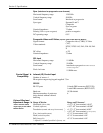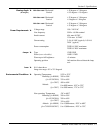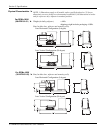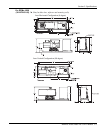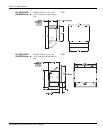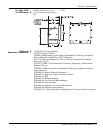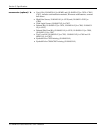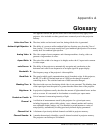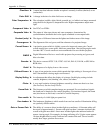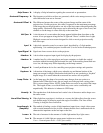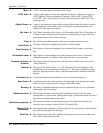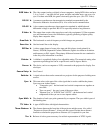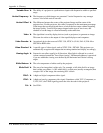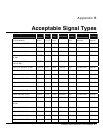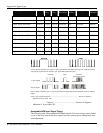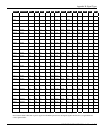
Appendix A: Glossary
A-2 RPMX/CX50/CX60/CX67 User’s Manual
A menu item that indicates whether an option is currently in effect (checked) or not
(unchecked).
A change in the tint of a white field across an image.
The coloration (reddish, white, bluish, greenish, etc.) of white in an image, measured
using the Kelvin (degrees K) temperature scale. Higher temperatures output more
light.
See YCbCr or YPbPr.
The output of video tape players and some computers, characterized by
synchronization, luminance and color signals combined on one output cable.
The degree of difference between the lightest and darkest areas of the image.
The alignment of the red, green, and blue elements of a projected image.
A projection screen which is slightly concave for improved screen gain. Curved
screens usually have screen gains, which are greater than 1 but viewing angles much
less than 180
°. Curved screens are not recommended for use with this projector.
Digital Micromirror Devices
used in this projector for processing red, green, and
blue color data.
This device converts NTSC 3.58, NTSC 4.4, PAL, PAL-N, PAL-M, or SECAM to
RGB video.
The sharpness of a display from a video source.
A type of rear-projection screen which spreads the light striking it. Screen gain is less
than 1 but audience viewing angles are increased.
An adjustment that affects the display of an image. Such display settings include
contrast, brightness, tint, blanking, size, offsets, and others.
A very rapid variation in image brightness caused by a frame rate that is too slow.
(See Interlace) See also Lamp Flicker.
The frequency at which complete images are generated. For non-interlaced signals,
the frame rate is identical to the vertical frequency. For interlaced signals, the frame
rate (also known as field rate) is one half of vertical frequency.
The intensity of visible light per square foot.
The luminance (brightness) which results from one foot-candle of illumination falling
on a perfectly diffuse surface.
The ability of a screen to direct incident light to an audience. A flat matte white wall
has a gain of approximately 1. Screens with gain less than 1 attenuate incident light;
screens with gain more than 1 direct more incident light to the audience but have a
narrow viewing angle. For example: An image reflecting off a 10 gain screen appears
10 times brighter than it would if reflected off a matte white wall. Curved screens
usually have larger gain than flat screens.
Checkbo
x
'
Color Shif
t
'
Color Tem
p
erature '
Com
p
onent Video '
Com
p
osite Video '
Contrast (ratio) '
Conver
g
ence '
Curved Screen '
DMD
'
Decoder '
Detail '
Diffused Screen '
Dis
p
la
y
Settin
g
'
Flicker '
Frame Rate '
Foo
t
-candle '
Foo
t
-lamber
t
'
Gain or Screen Gain '



